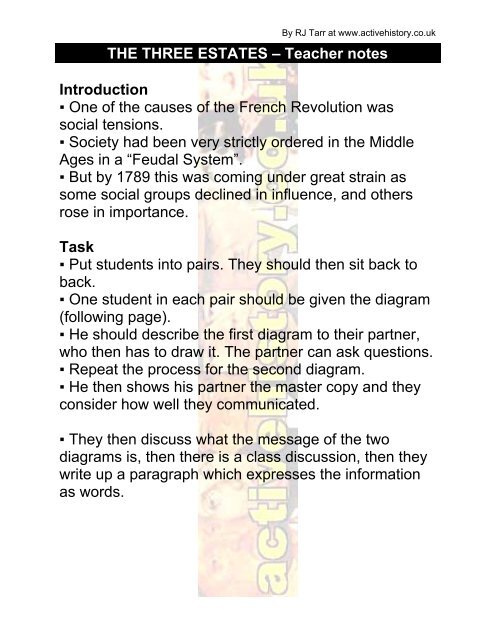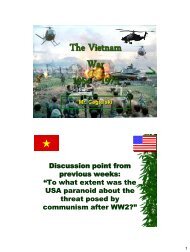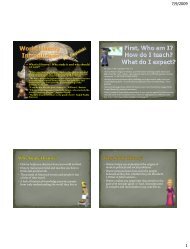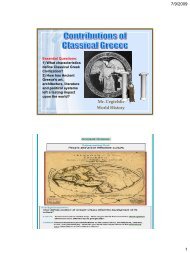THE THREE ESTATES - Mr. Schuhmann's Social Studies Class
THE THREE ESTATES - Mr. Schuhmann's Social Studies Class
THE THREE ESTATES - Mr. Schuhmann's Social Studies Class
Create successful ePaper yourself
Turn your PDF publications into a flip-book with our unique Google optimized e-Paper software.
By RJ Tarr at www.activehistory.co.uk<br />
<strong>THE</strong> <strong>THREE</strong> <strong>ESTATES</strong> – Teacher notes<br />
Introduction<br />
▪ One of the causes of the French Revolution was<br />
social tensions.<br />
▪ Society had been very strictly ordered in the Middle<br />
Ages in a “Feudal System”.<br />
▪ But by 1789 this was coming under great strain as<br />
some social groups declined in influence, and others<br />
rose in importance.<br />
Task<br />
▪ Put students into pairs. They should then sit back to<br />
back.<br />
▪ One student in each pair should be given the diagram<br />
(following page).<br />
▪ He should describe the first diagram to their partner,<br />
who then has to draw it. The partner can ask questions.<br />
▪ Repeat the process for the second diagram.<br />
▪ He then shows his partner the master copy and they<br />
consider how well they communicated.<br />
▪ They then discuss what the message of the two<br />
diagrams is, then there is a class discussion, then they<br />
write up a paragraph which expresses the information<br />
as words.
By RJ Tarr at www.activehistory.co.uk<br />
MIDDLE<br />
AGES<br />
1. Clergy<br />
2. Nobility<br />
3. Peasantry<br />
1789<br />
1. Clergy 2. Nobility<br />
3. Peasantry
By RJ Tarr at www.activehistory.co.uk<br />
The Estates (continued)<br />
▪ The First and Second Estate paid no taxes. All of the taxes were paid by the peasantry!<br />
The First Estate (The Church): They prayed for the King, so they were let off taxes. Their other<br />
responsibilities included the registration of births, marriages and deaths; they collected the tithe tax (10%<br />
of every peasants’ produce); they censored books; operated schools and hospitals; and distributed charity<br />
to the poor.<br />
The Second Estate (The Nobility): They fought for the King, so they were let off taxes. They also<br />
collected rent from the peasant population as well as customary dues [taxes] from the peasantry. There<br />
were dues on salt, cloth, bread and wine as well as on mills, granaries, presses and ovens.<br />
Task: What is the message of this cartoon? (Tip: use the points listed above to help you answer!)<br />
The First and Second Estates<br />
“The young Duke of Sonfranc has just got out of bed. He is already rich and is heir to a fortune that would<br />
make a hundred families wealthy. His servant is putting his stockings on him; his butler is bringing a cup of<br />
chocolate, and his secretary is writing tender little notes to the many young women the bored duke is<br />
courting” - By an eighteenth century writer<br />
“No less than 60% of the nobility lived in conditions where they found it hard to make ends meet. At the<br />
very bottom there were those who were too poor to possess a sword, a dog or a horse” - Historian Simon<br />
Schama<br />
▪ How do these two sources differ in their description of what life was like for the First and Second Estates?<br />
▪ Is it possible that both of them are telling the truth? Explain your answer.
By RJ Tarr at www.activehistory.co.uk<br />
The Third Estate<br />
The Peasantry<br />
“They live on bread made of barley and oats…the bread can sometimes be lifted by the straw sticking out of<br />
it. They also eat poor fruits and a few vegetables. They eat meat less than three times a year. Three<br />
quarters of them are dressed in half-rotting tattered linen. This hardship has its usual effects. It makes<br />
people weak and unhealthy, especially the children. The men become listless [idle] knowing that they would<br />
get nothing for their efforts” - Arthur Young, a British observer<br />
“[In the Bearn district of Southern France] I could hardly believe my eyes…a succession of well-built,<br />
comfortable farming cottages, each with a little garden. To every house belongs a farm…with grass borders<br />
mown and neatly kept. They are all in the hands of small owners…an air of neatness, warmth and comfort<br />
breathes over the whole” - Arthur Young, a British observer<br />
▪ How do these last two sources differ in their description of what life was like for the First and Second<br />
Estates?<br />
▪ Is it possible that both of them are telling the truth? Explain your answer.<br />
The Middle <strong>Class</strong>es<br />
“The Middle <strong>Class</strong>es were a many sided group, ranging from bankers, shipowners, manufacturers,<br />
merchants and tradesmen down to shopkeepers and workshop masters. They were the professionals and<br />
officials too…but they had no power over how the country was run” - Historian, C. Labrousse<br />
Task<br />
▪ Complete this table.<br />
Nobility / Clergy<br />
Ways their lives were good<br />
Ways their lives were bad<br />
Peasantry<br />
Middle <strong>Class</strong>es<br />
▪ Outline 3 ways in which you think that the situation of the country could be improved.<br />
1.<br />
2.<br />
3.









